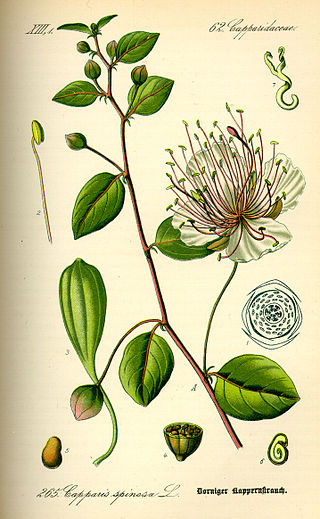
Capparis spinosa, the caper bush, also called Flinders rose, is a perennial plant that bears rounded, fleshy leaves and large white to pinkish-white flowers.

Belenois aurota, the pioneer or pioneer white or caper white, is a small to medium-sized butterfly of the family Pieridae, that is, the yellows and whites, which is found in South Asia and Africa. In Africa, it is also known as the brown-veined white, and is well known during summer and autumn when large numbers migrate north-east over the interior.
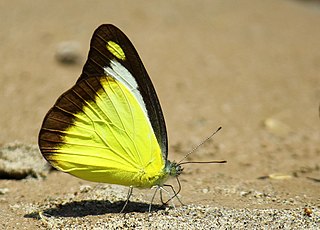
Appias lyncida, the chocolate albatross, is a butterfly of the family Pieridae, that is, the yellows and whites, which is found in south and southeast Asia.

The wild orange is an Australian native plant found in dry inland areas of Australia. Its scientific name is Capparis mitchellii. It is not related to oranges, nor to the Osage-orange which is known as "wild orange" in North America, but to capers.

Papilio anactus, the dainty swallowtail, dingy swallowtail or small citrus butterfly is a medium-sized butterfly from the family Papilionidae, that is endemic to Australia.
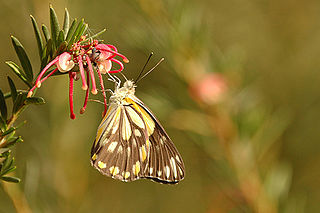
Belenois java, the caper white or common white, is a small butterfly of the family Pieridae found in Australia, Indonesia, and Melanesia. It is highly migratory and is often confused with the cabbage white.

Brithys crini, the amaryllis borer, crinum borer, lily borer or Kew arches, is a moth of the family Noctuidae. It is a garden pest in parts of its range, as their larvae damage the stems and leaves of lilies, especially lilies of the family Amaryllidaceae.
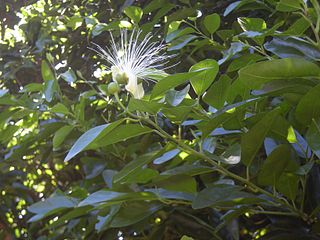
Capparis arborea is a bush or small tree occurring in eastern Australia. Its habitat is rainforest, usually riverine, littoral or the drier rainforests. It is distributed from the Hunter River, New South Wales to Cape Melville in tropical Queensland. Common names include native pomegranate, wild lime, wild lemon and brush caper berry. Capparis arborea is a host plant for the caper white , which migrate across the eastern seaboard in large numbers in the summer. It also feeds the chalky white

Dixeia pigea, the ant-heap small white or ant-heap white, is a butterfly in the family Pieridae that is native to Africa.

Elodina is a genus of butterflies in the family Pieridae. It is the only genus of the tribe Elodinini. It contains about 30 species.

Elodina angulipennis is a butterfly in the family Pieridae. It is found along the north-eastern coast of Australia.

Elodina parthia, the chalk white, is a butterfly in the family Pieridae. It is found in the Australian states of New South Wales and Queensland.

Elodina perdita, the northern pearl white or delicate pearl white, is a butterfly in the family Pieridae. It is found in the tropical north of Queensland, Australia.

Leptophobia aripa, the common green-eyed white or mountain white, is a butterfly in the family Pieridae. It is native to Mexico, Central America and South America, but strays may be found as far north as southern Texas.
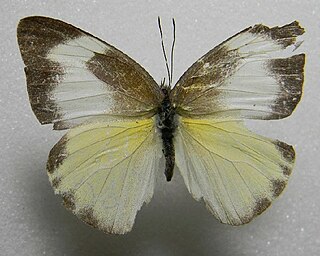
Appias drusilla, the Florida white or tropical white, is a butterfly in the family Pieridae. It is found in tropical America from Brazil north to southern peninsular Florida and the Florida Keys and Antilles. It frequently visits coastal Texas and is a rare stray to Nebraska and Colorado. The habitat consists of tropical lowland evergreen or semideciduous forests.

Pieriballia is a genus of butterflies in the family Pieridae erected by Alexander Barrett Klots in 1933. Its only species, Pieriballia viardi, the painted white or viardi white, was first described by Jean Baptiste Boisduval in 1836. It is found from Mexico to Bolivia and Paraguay. Strays can be found in southern Texas in the United States. The habitat consists of rainforests and transitional cloud forests.

Itaballia demophile, the cross-barred white, crossbarred white, or black-banded white, is a butterfly in the family Pieridae. It is found from the southern United States, and Mexico to Paraguay. The habitat consists of disturbed areas including forest clearings, riverbanks, roadsides, fields, cattle pastures and wasteland.

Itaballia pandosia, the Pisonis mimic or brown-bordered white, is a butterfly in the family Pieridae. It is found in the Amazonian regions of Brazil, Ecuador, Peru, and in Central America, Colombia and Venezuela. The habitat consists of primary rainforests. It may be a mimic of Moschoneura pinthous

Maerua cafra (DC.) Pax is a small Southern African tree belonging to Capparaceae, the caper family, occurring eastwards along the coast from Knysna, then further inland and northwards through KwaZulu-Natal and Eswatini to the Transvaal, southern Mozambique and southern Zimbabwe. The genus Maerua comprises about 60 species found in Africa and Asia.

Capparis lucida, commonly referred to as the coast caper, is a versatile plant that often grows as a small tree or a shrub, usually reaching heights of 3 to 4 meters. While it may sometimes climb, it typically produces flowers and fruits as a shrub. The leaves are glossy and range from 3 to 10 cm long and 2 to 5 cm wide, with a noticeable central vein and smaller veins forming loops near the edges. Both the petioles and twigs are covered in fine, soft hairs.



















